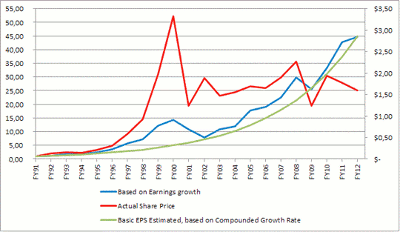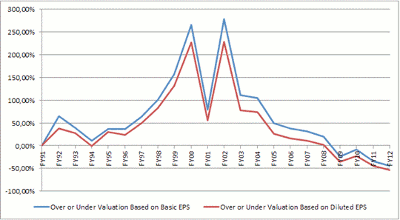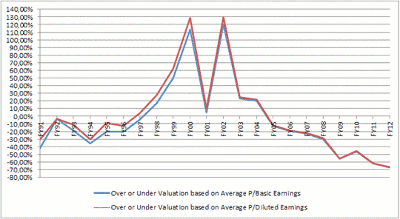Fundamental measures show that Microsoft (MSFT) is currently trading at a discount nearly 50% below one analyst’s fair-value estimate.
I will get immediately to the point for this MoneyShow.com article. I recently calculated a fair value of $48.91 for Microsoft Corp. (MSFT) based on fundamental analysis.
In this article, I will show you a bit of that analysis and add a few things to make the argument that MSFT is undervalued.
We will start with a history of earnings per share (EPS) and the evolution of the share price:
We can see that the EPS has been in a strong uptrend over the last 21 years.
If we calculate the earnings growth year over year and assume that price would have risen just as much as EPS each year (an annual compound rate of 20, 20% for basic EPS, and 21.25% for diluted EPS), price should have risen from $0.94 (the closing price of the last trading day of 1990) to $44.81 at the moment.
As MSFT is currently trading around $25, we can see that the share price has lagged earnings growth. We can also clearly see the effects of the Internet bubble in 2000, when the share price rose too much when compared to EPS. When bubbles burst, it takes time—a lot of time—before the uptrend can resume.
NEXT: One Valuation Measure Far Exceeds the $50 Target
|pagebreak|When we measure the over- and undervaluation based on earnings per share growth, we can clearly see that MSFT was severely overvalued in 2000:
Based on this model, MSFT would now be 43.98% undervalued based on basic EPS growth and 53.32% undervalued based on diluted EPS growth. Based on this model, MSFT should be trading at $44.81 and $53.77, respectively, which is in line with the fair value we calculated in this report back in the middle of May.
Over the last 21-22 years, MSFT has traded at an average price-to-basic-earnings ratio of 25.45 and an average price-to-diluted-earnings ratio of 26.84.
If we multiply those averages with the earnings per share each year, we get a price target that corrects for sky-high price-to-earnings levels of 2000, but also the very low price/earnings (P/E) ratios of the last four years.
We then calculate the over- and undervaluation of the actual share price in one year to the estimated share price based on the average price/earnings ratio. The result is the following chart:
Based on this model that uses historical averages, MSFT is approximately 67% undervalued and should be trading at $76.
In Conclusion
Although this model is not waterproof, it is interesting to put MSFT’s recent share price in historical perspective. Based on this analysis and our fair-value calculations, MSFT is severely undervalued now.
(To obtain the Excel sheet used for calculations and graphs, please click here. Data obtained from Microsoft’s Web site and Zacks Research Wizard.)
By Willem Weytjens of Profitimes.com

























